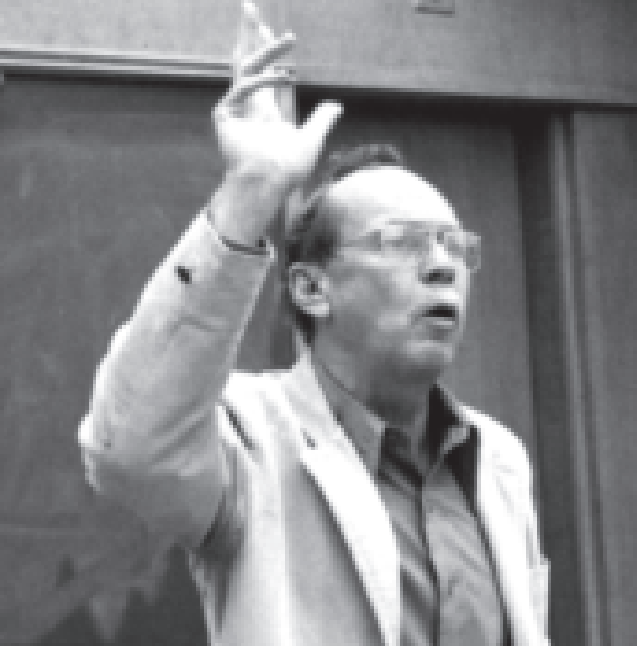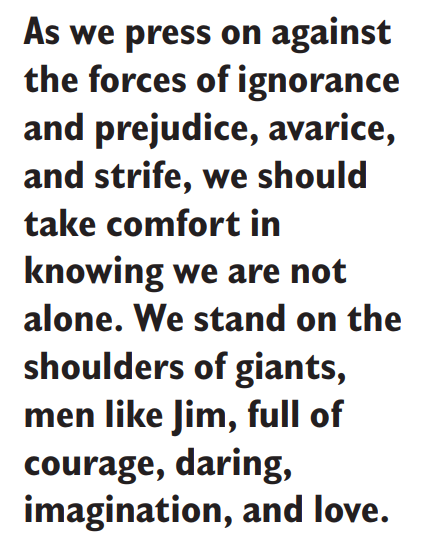James A. King died on February 13, 2007 at the age of 85. Jim King was an active member of the Oahu ILWU pensioners club and a retired labor attorney. Jim came from a prominent kama’aina family with deep roots in Hawaii. His mother’s family could trace their ancestry to Hawaiian alii and his grandmother, Charlene Davis, had served as a personal assistant to Queen Liliuokalani. His grandfather, James Anders King was the Minister of the Interior for the Republic of Hawaii and his uncle was Territorial Governor Samuel Wilder King.
Jim attended Punahou School, the University of Hawaii, and graduated from Georgetown University, before serving in the US Army in 1942-1945 during World War II. Jim was assigned to the 45th Infantry Division and fought in the bloody conflict on the front lines in Italy and France. In 1945, his Battalion was ordered to hold two peaks in the Vosges Mountain but was overrun and captured by the enemy. Jim spent the remaining six months of the war in a German prison camp.
The war would change the direction of Jim’s life. In his own eulogy, Jim wrote: “WW II was a defining time of his life: he felt if he survived he would do what he could to oppose wars, assist workers, and their organizations (unions) and foster social progress. He hopes to some extent he has done so.”
After the war, Jim obtained a Law Degree in 1948 from Columbia University. He returned to Hawaii and, keeping his promise to assist workers and foster social progress, he joined the law firm of Bouslog & Symonds in 1949.
Bouslog & Symonds was the only law firm in Hawaii that represented the interests of working people and their unions. The firm represented attorneys who worked for the firm included Hideki Nakamura and Edward Nakamura who also served as chief justice of the Hawaii Supreme Court.

James King at a Steward’s Council meeting in 1979.
When the principal partners of the law firm, Harriet Bouslog and Myer Symonds retired, the attorneys in the firm continued serving the labor community as the law firm of King, Nakamura and Chun-Hoon and the law firm of Takahashi, Vasconcellos, (and Covert). Both law firms represented the ILWU and other unions, as well as thousands of injured workers with their workers compensation cases.
King retired in 1996 but continued his involvement in the labor movement as an active member of the ILWU Oahu Pensioners Club. He is survived by wife Alma, daughters Donna Lance and Stephanie Kaumeheiwa, and seven grandchildren. ◆
Eulogy for Jim King
Lowell Chun-Hoon, who practiced law with Jim from 1977 to 1996, wrote and delievered the eulogy for Jim King at a grave side cermony on Feb. 23, 2007. The following piece from that eulogy describes some of the major accomplishments of Jim’s career as a labor attorney.
Though he was predominantly a labor lawyer, Jim practiced in almost every conceivable venue, handling more than his share of personal injury, family law, criminal, and estate and trusts issues for members of ILWU Loca1142, United Public Workers Loca1646, and Carpenters Local 745. He joined the firm of Bouslog & Symonds in 1949, after the ILWU had succeeded for the first time in organizing sugar workers, when the union faced four hundred pending trials of striking employees. However, not a single Hawaii lawyer would represent them. Harriet and Sy were both founding members of the National Lawyers Guild, and they challenged the territorial Unlawful Assembly and Riot Acts, fought injunctions against strikes, and defended the 1949 dock strike.
Sy and Harriet represented the 39 reluctant witnesses before the US. House Un-American Activities Committee and Senate Judicial Internal Security hearings and had them take the Fifth Amendment. The government argued the 5th amendment could not be invoked in a congressional hearing but Judge Delbert Metzger sustained the use of the privilege, the first ruling of its kind in the United States. They also represented the Hawaii Seven, including Jack Hall, in a seven and half month trial, when the Seven were charged under the Smith Act with conspiring and teaching the overthrow of government by force and violence. The Seven were initially convicted at trial but ultimately exonerated after a favorable decision of the US. Supreme Court in a paral1el case. While Jim was not lead counsel in these cases, he, Ed Nakamura and Nadao Yoshinaga were part of the five person legal team that essentially held the entire territorial and federal government at bay in its attempt to quash the labor movement in its infancy.
As organized labor became accepted into the fabric of Hawaii’s social and economic life, the nature of the legal conflicts trade unionists confronted changed from battling for their very existence toward enhancement of basic rights and benefits. One of the greatest milestones of this advancement arose from Jim’s most celebrated case, Akamine v. Hawaii Packing and Crating, 53 Haw. 406 (1972), Edward K. Akamine suffered a heart attack on January 19, 1968 after Loading, stacking and hand trucking cargo from container trucks to cargo bays for five to six hours.. One cardiologist opined that his work activity did not in any way aggravate, accelerate, precipitate, or cause his attack, that it could have happened anywhere, even in bed, and that its occurrence on the job was mere happenstance. However, Akamine’s personal physician stated simply that it was not possible to know with any certainty why the infarction occurred.
Having lost at the Department of Labor and at the Labor and Industrial Relations Appeals Board, Jim took an appeal to the Hawaii Supreme Court, relying on the presumption in Section 386-85 HRS. This provision states, “It shall be presumed, in the absence of substantial evidence to the contrary: (1) That the claim is for a covered work injury.” From these twenty-two words, comprising only one sentence, Jim fashioned an argument that persuaded the Hawaii Supreme Court to rule in 1972 that whenever there was reasonable doubt about factual conflicts concerning an industrial accident, the humanitarian purpose of the statute required that this doubt be resolved in favor of the injured worker. In a second enormous precedent, Chung v. Animal Clinic, 63 Haw. 642 (1981) argued by Hideki Nakamura, the court ruled in 1981 that the veterinarian’s heart attack sustained while jogging on the Kalani High School track after work also arose out of and in the course of employment because medical evidence demonstrated that employment stress was a contributing cause to Chung’s heart condition.
Now, thirty-six years after Akamine, the outcries of wounded insurance adjusters still reverberate through the Department of Labor and Industrial Relations building at 830 Punchbowl Street, sometimes even carrying one block mauka to Ali’iolani Hale and the appellate courts. In reality, Akamine “leveled the playing field” for almost two generations so that employees, even those unrepresented by counsel, have a fighting chance to have their industrial accident claim successfully adjudicated.

Like all labor lawyers of his generation, the guts of Jim’s practice was in a myriad of unpublicized claims over herniated discs and repetitive motion disorders, social security disability and unemployment insurance adjudications, arbitrations concerning discharges, suspensions, and contract interpretation; as well as esoteric unfair labor practices over organizing elections, placement of picket lines, and execution of secondary boycotts.
In 1979, Jim lead a team of four lawyers in the statewide United Public Workers strike resisting strike injunctions on every island and battling health and safety proceedings at the Hawaii Public Employees Labor Relations Board. Where the public had once splashed red paint on the office during the heyday of McCarthyism, irate citizens telephoned their threats to dump their garbage on the doorsteps of the law firm during the height of the six week work stoppage.
For those of us who remain, Jim’s life was truly humbling, but hopeful. As we press on against the forces of ignorance and prejudice, avarice, and strife, we should take comfort in knowing we are not alone. We stand on the shoulders of giants, men like Jim, full of courage, daring, imagination, and love. ◆
